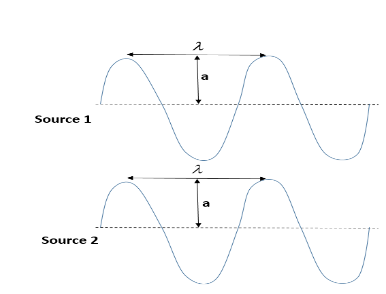
What is meant by coherent sources of light?
Answer
524.4k+ views
Hint: We know that interference is a phenomenon in which two waves from distinct sources form a resultant wave either of high, low, or having the same amplitude. But, we don’t see interference patterns everywhere as most of the sources generate light waves randomly. It means the light waves do not have a constant frequency, phase, or amplitude. That means they are not coherent. So we will be discussing coherency of light sources.
Complete answer:
If we look at light coming out of a bulb, it is randomly generated every moment in all directions. That is the starting point of the wave generated may be minimum, maximum, or any point in between. So, we cannot predict at which phase the wave will start. These types of sources are called incoherent sources.
Now, if two sources are said to be coherent, then the waves emitted from those sources will have the same frequency and constant phase difference. Coherent sources are used for observing the effects of certain optical phenomena like interference. For this, two equivalent slits are lighted by a laser beam which will act as coherent sources.
So, we can conclude that two sources of light are said to be coherent when they have light waves of same
a) Phase and amplitude
b) Wavelength and constant phase difference
c) Intensity
d) Speed
Characteristics of coherent sources are as follows.
1) Waves generated by the two sources will be having constant phase difference.
2) Waves generated by the two sources are of a single frequency.

Note:
We must be aware that for interference of two waves to happen, it is necessary that the two sources must be coherent. As examples for coherent sources, we can take the emitted light from a laser which has the same phase and frequency. Another example is sound waves having the same frequency and phase.
Complete answer:
If we look at light coming out of a bulb, it is randomly generated every moment in all directions. That is the starting point of the wave generated may be minimum, maximum, or any point in between. So, we cannot predict at which phase the wave will start. These types of sources are called incoherent sources.
Now, if two sources are said to be coherent, then the waves emitted from those sources will have the same frequency and constant phase difference. Coherent sources are used for observing the effects of certain optical phenomena like interference. For this, two equivalent slits are lighted by a laser beam which will act as coherent sources.
So, we can conclude that two sources of light are said to be coherent when they have light waves of same
a) Phase and amplitude
b) Wavelength and constant phase difference
c) Intensity
d) Speed
Characteristics of coherent sources are as follows.
1) Waves generated by the two sources will be having constant phase difference.
2) Waves generated by the two sources are of a single frequency.

Note:
We must be aware that for interference of two waves to happen, it is necessary that the two sources must be coherent. As examples for coherent sources, we can take the emitted light from a laser which has the same phase and frequency. Another example is sound waves having the same frequency and phase.
Recently Updated Pages
Master Class 11 Economics: Engaging Questions & Answers for Success

Master Class 11 Accountancy: Engaging Questions & Answers for Success

Master Class 11 English: Engaging Questions & Answers for Success

Master Class 11 Social Science: Engaging Questions & Answers for Success

Master Class 12 Biology: Engaging Questions & Answers for Success

Master Class 12 Physics: Engaging Questions & Answers for Success

Trending doubts
Which are the Top 10 Largest Countries of the World?

Differentiate between homogeneous and heterogeneous class 12 chemistry CBSE

Why is the cell called the structural and functional class 12 biology CBSE

Sketch the electric field lines in case of an electric class 12 physics CBSE

State and explain Coulombs law in electrostatics class 12 physics CBSE

a Tabulate the differences in the characteristics of class 12 chemistry CBSE




